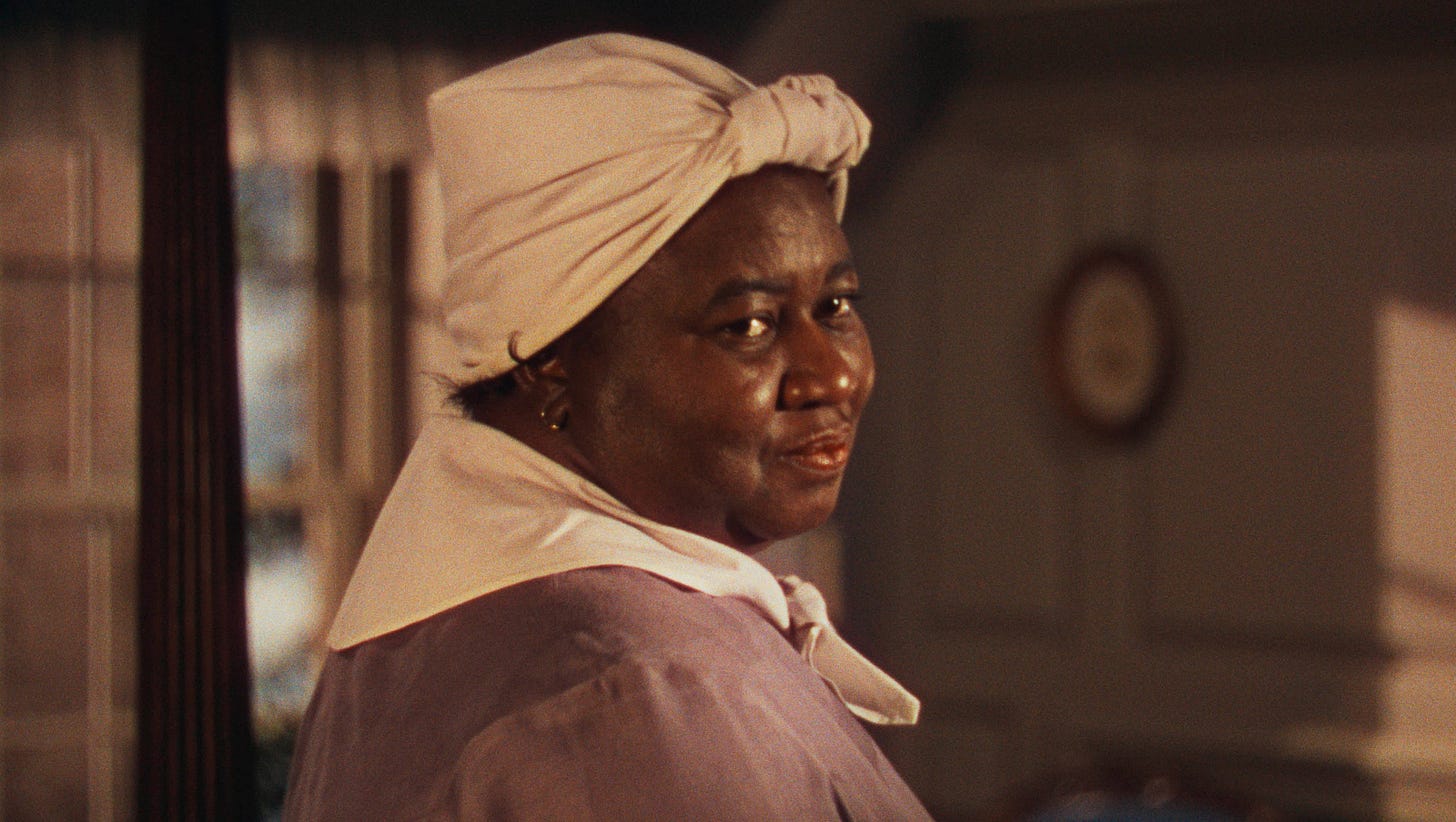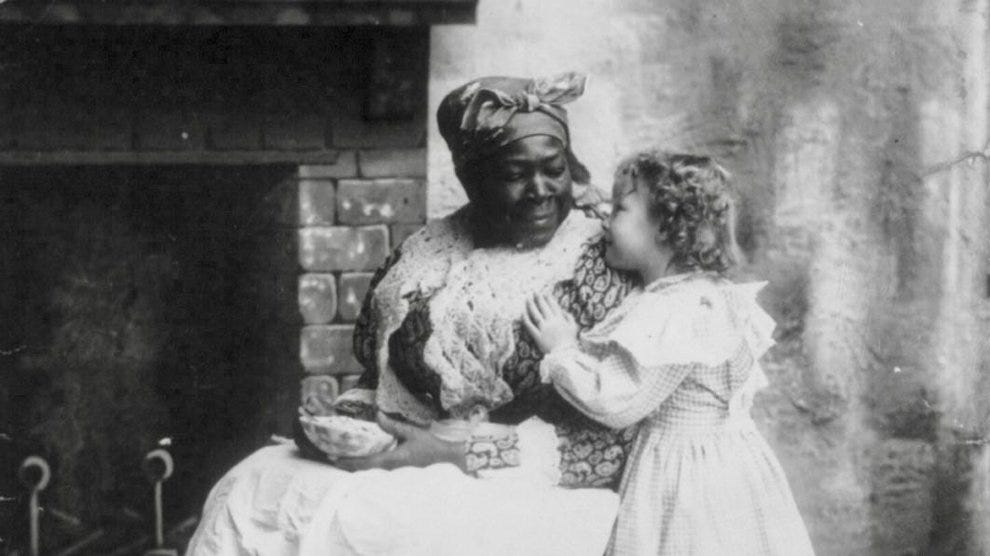Confession. I’m a bosommy girl. I tried out for a play once. I was 19 and had to play the mother of a 35-year-old. The (idiot) director said I had a “mother vibe.” A TikTokker set the FYP buzzing by declaring that when he watched Sinners, he thought Annie and Smoke had a mother-son vibe. The question everyone posed to him was why.
We know why babes— the pervasiveness of the Mammie archetype in American media, Annie's character, specifically her nurturing presence and physical form, represents a powerful reclamation of Black female bodies in American cinema. Let’s get into it.
The Mammy Trope: A Quick Anthropological Tea Break
Before we get to Annie and smoke, let's get clear on what we're talking about. The "mammy" figure in American media is one of the most persistent and problematic stereotypes of Black women – a desexualized, maternal figure whose entire existence revolves around caring for white families. Think Hattie McDaniel in "Gone with the Wind," whose performance won her an Oscar she couldn't even properly accept because of segregation.
Anthropologically speaking, the mammy trope served a specific cultural function: to reframe the exploitation of Black women's bodies and labor as willing servitude. As cultural anthropologist Dr. Patricia Hill Collins notes in her seminal text "Black Feminist Thought" (1990), "The mammy image represents the normative yardstick used to evaluate all Black women's behavior."
The visual hallmarks of this trope typically include:
A full-figured body, particularly a large bosom
Maternal but never sexually desirable
Nurturing to others but never prioritizing herself
Wisdom that exists only to serve others
As feminist scholar bell hooks writes in "Ain't I a Woman" (1981), "The mammy image was designed to mask the exploitation of Black domestics... by perpetuating the notion that Black women were content to serve." I think of this as the #StrongBlackWoman Trope but with triple-D cups. Annie flips this completely.
From Bosom to Titties
I think what "Sinners" does brilliantly is take these visual cues and completely rewrite their meaning. Annie's full figure and nurturing presence aren't framed as characteristics that make her suitable for serving others. Her bosom is transformed from symbol of servitude to source of power- turning bosom into titties.
Wunmi Mosaku herself describes in an interview with the New York Times: "Her love for Smoke is so powerful that she gave everything she had to his mojo bag." Annie's physicality – particularly her bosom – becomes a visual representation of the abundance of power, not servitude. It's the source from which her healing flows, not a body meant to comfort white children. Recent works by Black creators have reclaimed Black women's breasts as sites of power, pleasure, and autonomous decision-making. The deliberate use of terms like "titties" in some Black creative works represents a rejection of both the sanitized "bosom" and the objectified "breasts" of white male fantasy.
Please enjoy….for educational purposes, this TikTok edit of Smoke falling into Annie’s body as she reinforces the sexual power in her body.
Hoodoo and the Body
What takes Annie beyond just subverting a trope is the connection of her physical form to ancestral spiritual practices. Wunmi mentions in an interview that playing Annie connected her to her own Yoruba heritage through exploring hoodoo, which has roots in Ifa.
Anthropologist Dr. Yvonne Chireau, in her book "Black Magic: Religion and the African American Conjuring Tradition" (2003), explains that "the bodies of female conjurers were understood to be vessels of extraordinary power." Their physical forms were conduits to ancestral wisdom and spiritual forces.
This is exactly how Annie functions in "Sinners." Her physicality is essential to her role as a healer and protector.
Why This Matters: Cultural Reclamation in Real Time
Ok… I spend my days rewriting Jane Austen with Black heroines, and Annie has me feeling SEEN. Annie’s healing hands, ancient knowledge, and yes, those powerful titties ain’t apologizing to ENTY-BODY. Her power isn't for consumption, which is why she begged to be staked when the time came. She is caring for her community, but the thing that she has that Mammies don’t: Agency. The choice to do it or not.
What Coogler has accomplished with Annie is a sort of cultural reclamation. By taking visual cues that have historically been used to stereotype and dehumanize Black women and recontextualizing them as sources of power, "Sinners" participates in what anthropologist Dr. Faye V. Harrison calls "decolonizing anthropology" – the process of reclaiming cultural narratives from oppressive frameworks. When I write Jane Austen retellings focused on Black women’s joy, I imagine myself to be a part of this same project.
Annie's character – with her healing hands, her ancient knowledge, and yes, her big boobs has enormous agency. I think it’s telling that the last time we see Annie is breastfeeding. She decides who gets access to her gifts, her knowledge, and her heart. She’s a reclamation of what the mammy stereotype tried to exploit: the profound power of Black women's care, which, when freely given rather than coerced, is revolutionary.
Sources:
Collins, Patricia Hill (1990) "Black Feminist Thought: Knowledge, Consciousness, and the Politics of Empowerment"
Chireau, Yvonne (2003) "Black Magic: Religion and the African American Conjuring Tradition"
hooks, bell (1981) "Ain't I a Woman: Black Women and Feminism"
Harrison, Faye V. (1991) "Decolonizing Anthropology"
Lorde, Audre (1978) "Uses of the Erotic: The Erotic as Power"
Walker, Alice (1982) "The Color Purple"









This is Substack Premium-- Incredible
This is beautiful work Nikki. Fantastic analysis